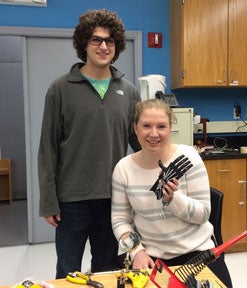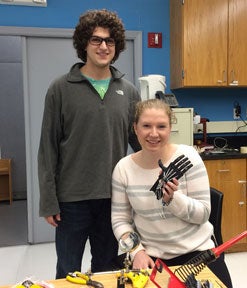 KINGSTON, R.I., Jan. 12, 2016 — Let’s say you’re late for class at the University of Rhode Island and you need to find a parking space—fast. Or you need a robotic hand to retrieve something. Or you want to monitor the temperature in your lab without actually being there.
KINGSTON, R.I., Jan. 12, 2016 — Let’s say you’re late for class at the University of Rhode Island and you need to find a parking space—fast. Or you need a robotic hand to retrieve something. Or you want to monitor the temperature in your lab without actually being there.
URI engineering students have your problems solved, thanks to an intensive 12-day course they took during winter break called Engineering Entrepreneurship and led by engineer and entrepreneur Rajesh Nair.
The 3-credit course is part of J Term, classes and sessions on campus and overseas during the break to provide new and creative educational opportunities for students.
Nair is a visiting scholar at the Massachusetts Institute of Technology and director of The Innovation and Entrepreneur Center at the Asia School of Business in Kuala Lumpur, Malaysia. The other instructor was James Miller, professor of ocean engineering who also happens to be an entrepreneur as co-founder of FarSounder, a marine sonar company in Warwick.
What does it take to be a successful entrepreneur?
“In one word—confidence,” says Nair. “All entrepreneurs are innovators who want to solve problems.”
The seven students, ranging from a sophomore to seniors, are studying civil, mechanical and ocean engineering. While their friends were skiing, these students were working 12-hour days in Gilbreth Hall on projects that are useful, creative and downright amazing.
“It was the right kind of schedule for this kind of course,” says Miller. “It was intense.”
The three teams each created three projects that got more advanced as the days progressed. First, they had to make a toy for cats; then they had to build something to solve a real-world problem. For the last project, they were charged with making something that could lead to a business.
Joe Saccoccia, of Cranston, and Taylor Campbell, of North Kingstown first created the “Rodent Runner,” a kind of mini cart that zips off when a cat nears. A laser at the rear lures in the feline, but as the cat approaches a sensor triggers the motor and the cart speeds away—at a 45-degree angle to mimic darting creatures, no less. The two also created a container that dispenses food to pets regularly—a must-have for pet owners who work during the day. The final project was the “Hurry App” to help drivers find parking on campus. Sensors count the numbers of cars going in and out of lots, providing alerts on the app about available spaces.
“No matter what field of engineering you’re in you should be exposed to things like this,” says Saccoccia. “There’s a disconnect between books and courses like this.”
Adam Mazzantini, of Cheshire, Mass., and Sarah Visich, of Wakefield, made a cat toy that uses a joystick to rotate a ball. Their second project tackled stand-alone mailboxes. The problem: It’s difficult, if not impossible, to reach inside those mailboxes from a car window. The solution: A drawer that pulls in and out and is easily accessible from the car. The final project was a robotic hand—born out of concern for Visich’s mother who is in a wheelchair and has trouble reaching things. The ultimate goal of the “Handy-Can” is to attach the robotic hand, with an extendable arm, to a wheelchair.
“Here, we got to look at what’s going on outside the classroom,” says Visich. “We also learned how to identify a problem and think about different solutions, instead of the other way around.”
Mazzantini agreed: “The class opened me up to a lot of new opportunities that I wouldn’t have experienced in a core curriculum class. Happy to give up hiking and biking for this.”
Kevin Lapierre of Woonsocket, Kevin Stabinsky of Ellingston, Conn., and Eilish Finneran, of Narragansett, also created a cat toy, but their gem was a sensor system that measures temperature, humidity, sound and motion in laboratories. The system, called “Temp-Guard,” sends a text alert if something is amiss.
“I am truly getting a hands-on experience,” says Lapierre. “That’s important. I feel like when you’re trying to get a job in the real world, that’s what they want.”
And it’s exciting, he says, to think about how to turn an idea into a business.
“Now I’ve got the tools for a start-up. I also know how to make an app to turn my lights on at home. That’s cool.”
The students will demonstrate how their products work Wednesday, Jan. 13, at 12:30 p.m., in Gilbreth Hall, Room 125, on the Kingston campus. The course is part of the College of Engineering’s new minor in engineering entrepreneurship. For details about the coursework, contact Miller at miller@uri.edu.
Pictured above: Adam Mazzantini, left, and Sarah Visich, right, display a robotic hand they made during a 12-day J-term course called Engineering Entrepreneurship. Photo courtesy of URI.

